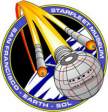 |
 |
Bison-Class Transports
![]() Overview
Overview![]()
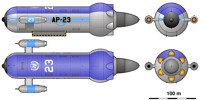 Bison - UESN version |
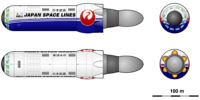 Bison sleeper ship |
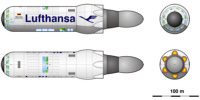 Lufthansa starliner |
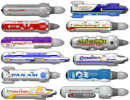 Bison variants in various liveries |
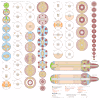 Cargo ship deck plans created by Allen Rolfes (see notes) |
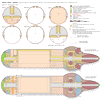 Cargo variant deck plans created by Allen Rolfes (see notes) |
 Sleeper ship deck plans created by Allen Rolfes (see notes) |
 Passenger ship deck plans created by Allen Rolfes (see notes) |
 Passenger ship refit deck plans created by Allen Rolfes (see notes) |
![]() Scenes
Scenes![]()
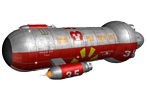 3D model created by Fabio Passaro © 3D Gladiators |
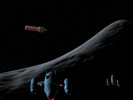 Pirates ambushing a Bison class created by Thomas Pemberton © 3D Gladiators |
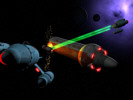 The pirates attack created by Thomas Pemberton © 3D Gladiators |
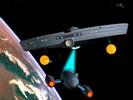 U.S.S. Mexico comes to the rescue created by Thomas Pemberton © 3D Gladiators |
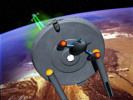 The pirate slips the net created by Thomas Pemberton © 3D Gladiators |
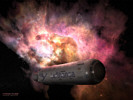 Gute Reise! created by Phillip Jackson |
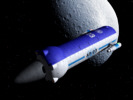 UES Aldebaran created by Dávid Metlesits |
 UES Aldebaran created by Dragonpyper |
![]() History
History![]()
Despite its old-fashioned name, the United States Rocket and Spacecraft Corporation (USRSC) of Houston, Earth, had a reputation for building some of the most robust and technologically advanced starships of the United Earth (UE) and the early United Federation of Planets (UFP). In particular, USRSC's Bison transport, introduced in 2145, was the most common cargo starship on the spacelanes connecting the UE with its colonies and neighbors. One reason for Bison's popularity was its amazing adaptability. Variants of the Bison included tankers for deuterium and gases; transports for unrefined ores, agricultural products, chemicals, and manufactured goods; passenger liners; cargo liners; hospital ships; and megalifters for large cargo, such as fusion reactors, warp nacelles, and starship hulls. In the mid-20th century, the Boeing Aircraft Corporation had been jokingly accused of producing a single continuous airliner fuselage, which was cut into desired lengths like an enormous sausage. However, this joke became a business model for USRSC's Bison. The modular construction of Bison's single-diameter cargo hull allowed the length and internal arrangement of each ship to be built according to a customer's wishes. Furthermore, reactors and warp nacelles (either single-midline or twin-outboard or both) could be arranged in various ways and replaced as more advanced components became available. USRSC was presumably not referring to quality-control problems when it proudly proclaimed in 2150 that no two Bisons were identical.
The most common early Bison hull (type B3), introduced in 2147, was a hemisphere-capped payload cylinder 54 m in diameter and 184 m long. As was usual for ships of the period, the decks were stacked along the longitudinal axis of the ship. The most-forward part of the hull held the navigational sensors, deflector, crew quarters, computer systems, and the bridge. The remainder of cylinder could be configured in multiple ways for interstellar or intrasystem transport of various payloads: passengers or cargo or both. Behind the payload cylinder was a 71-m diameter sphere that held deuterium tanks, the main reactor to power the warp drive (fusion reactors for civilian ships before 2161), and the impulse drive reactor. The warp nacelle was most often a single midline unit directly behind the reactor/fuel sphere and was occasionally supplemented by foreward-mounted mininacelles to enhance warp maneuverability. For the same reason, dual outboard main nacelles were occasionally mounted instead of a single midline main nacelle.
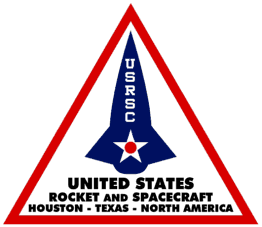
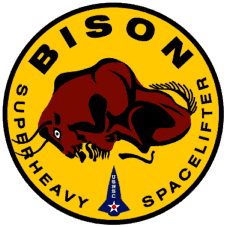
Early Colonization Efforts
Long before the introduction of the Bison in 2145, Humans had begun colonizing their own solar system and nearby systems. Scientific research stations were established on Luna and Mars in the last third of the 20th century, and within 50 years settlements had been established on all other habitable planets and moons of the Sol system and throughout the asteroid belt. The solar system was alive with activity: scientific research, engineering, agriculture, art, and Human reproduction. The 2150 UE census, the last before the start of the Earth-Romulan War, showed that more than a half billion people lived off-Earth within the Sol system. Bison and other similar ships brought raw materials from the asteroid belt and the Outer Satellites sunward to the Inner Planets, where they were turned into manufactured goods for distribution throughout the system. With warp drive, traveling from Earth to Mars took as little time as traveling from New York to Tokyo by suborbital shuttle. Even traveling at a leisurely speed of
wf 1, cruise ships could complete a "grand tour" of the solar system's major planets and moons in less than 24 hours.
Surprisingly soon, the Sol system had become too small for Human ambition. Extrasolar colonization had begun even before the discovery of warp drive: impulse-drive ships barely able to reach 0.25 c (the "Quarter-C Drive") established a Western Alliance outpost on Alpha Centauri in 2024, soon before the start of World War III. With the development of Earth's warp drive by Zefram Cochrane in 2063, Earth resumed extrasolar exploration and colonization. By the start of the Earth-Romulan War in 2156, a wide variety of colonies had been established within 25 ly of Earth. Many colonies had been established for a single purpose, such as mining, agriculture, military outposts, or refueling stations, and were entirely reliant upon corporations or sponsoring agencies for their continued existence. A handful of colonies had broad-based, self-sustaining economies and populations of millions, built through a combination of large-scale immigration and high birth rates. They were fast becoming new Earths, consuming and producing vast quantities of goods and resources and serving as bases for establishing even more distant colonies. Other colonies had been founded by small separatist groups united by a common faith or philosophy and a disdain for modern UE society; some of these colonies thrived, while others slowly withered or imploded in violence and chaos in forgotten sectors of space.
To support its colonization efforts, the UE established the Colonial Transport Service, which set up forward colonization bases and refueling stations; brought some colonists to their new homes; made periodic visits to bring food, fuel, medicines, and equipment; and, when necessary, evacuated failed colonies. However, because of the great distances involved, some new colonies, especially in the Libra colonies 20 ly above Earth, could not expect to be visited by supply ships more than once every few years. As late as the 2230s delays in relief ships reaching starving colonies lead to unspeakable tragedies.
Limitations of Fusion Power
Before the widespread commercial availability of matter/antimatter (M/AM) warp drive systems after the Earth-Romulan War, civilian interstellar travel was costly and time-consuming. Even for the newest Bison passenger liners outfitted with the most advanced deuterium-fueled fusion reactors, traveling from the Sol system to its closest neighbor, Alpha Centauri, a mere 4.3 ly away, took 129 days at a cruising speed of
wf 2.3. (Bison cargo ships were limited to a cruising speed of wf 2.2 and took nearly 5 months to reach Alpha Centauri). Ships introduced before Bison were even slower, being limited to a cruising speed of
wf 1.7 or less. To travel further than 6.5 ly or faster than wf 2.2 (maximum sustainable speed was
wf 2.4 which limited the range to 3.4 ly), Bisons were required to refuel at stations established in interstellar space, to rendezvous with or be accompanied by deuterium tankers, or to sacrifice payload for additional deuterium carried internally. All of these methods were costly, making high-speed interstellar transport prohibitively expensive except for passengers and the most valuable commodities.
However, regardless of the cost or distance of travel, there could be little further increase in the speed of fusion-powered ships, which had neared their theoretical limits by the 2130s. For this reason, interstellar passengers included only the most determined colonists, diplomats, businessmen, and government officials. Despite these difficulties, interstellar travel did occur between the UE and its colonies and among the small cluster of star systems that would later found the UFP. By far the most heavily traveled route was that between the Sol system and its first and most populous colony system, Alpha Centauri. Several shipping lines, including Centauri Spaceways, Burke Transgalactic, and Zhang-Blue Dragon, made weekly runs to and from the Centauri colonies, carrying both passengers and cargo. This route was well marked by navigational beacons and regularly patrolled by UE police cutters. Other colonies, however, might be visited by starships only monthly or yearly or even less frequently, depending on their population, economic and political importance, and proximity to major space lanes. Some mining colonies were worked only by automated equipment, so might be visited by robotic ore transports to pick up mined ore only once or twice a decade. (See star chart, "United Earth, Andorian, Tellar, and Vulcan Systems, 2155".)
Sleeper Ships
Because of the 4-month travel time and the costs of feeding, accommodating, and entertaining passengers, most travelers to Alpha Centauri (and star systems of similar distance) during the prewar and early postwar periods traveled unconscious in hibernation chambers. Although sleeper ships had not been needed for intrasystem travel since the development of the "quarter-c" sublight impulse drive, sleeper ships continued to carry the majority of interstellar passengers until faster ships, such as the wf-4 Sozvezdie (Constellation), became widespread in the late 2170s. Unlike modern stasis sleep, which is easily induced and reversed, sleeper ship "hibernation" in the mid-22nd century was actually a type of artificial coma induced by hypothermia, neurodepressive medications, and selective electronic encephalic stimulation. The passenger's body temperature and metabolic, neural, pulmonary, and circulatory functions were reduced to extremely low levels. Such suppression of normal bodily activities required extensive preconditioning and preparation, lasting as long as 1 week. Hibernation itself was induced over several hours, and complete recovery from its effects at the end of the journey took several days.
All commercial passenger lines used similar preconditioning and hibernation regimens. First, passengers wishing to travel underwent a preflight examination by company physicians to help ensure that they were medically fit to endure the preconditioning and hibernation processes without complications. Although deaths during hibernation were rare with properly maintained equipment, as many as 10% of apparently healthy persons were "allergic" to the associated pharmaceutical agents or to hibernation itself, so were unable to travel or were forced to travel without hibernation at greatly increased cost. Once cleared for travel, in the week before departure passengers would undergo a preconditioning regimen that included the administration of various drugs, nutrients, and intravenous fluids (to prevent cellular damage) and treatments to purge the body of wastes. Monitors and stimulation leads, relief catheters, and drug and fluid administration ports were placed. For the actual journey, passengers would enter the hibernation chambers, where all the lines were attached. The passengers were rendered unconscious and, over the next several hours, entered a state of hibernation that would last the next 4 months or more. Upon arrival at the destination, passengers would undergo a revival process to reverse hibernation and restore complete wakefulness over several hours. However, complete recovery from the effects of hibernation might take as long as 1 week for the journey to Alpha Centauri.
The details of the preconditioning and hibernation procedures, however, differed with the class of passage. A typical Bison sleeper ship carried 3,420 passengers: 360 in first class and 3,060 in second class. First-class passengers were visited at their homes by company physicians for the required preflight tests and examinations. The day of departure, the passengers would travel to the departure terminal and be greeted by the ship's senior officers as they boarded. After the ship had broken orbit, climbed above the ecliptic, and reached its warp cruising speed, the passengers were free to visit the ship's entertainment facilities or retire to their private cabins, to which hibernation chambers were attached. Most passengers entered hibernation within 1 week after departure, but some passengers elected to wait 1 month or more so that they could enjoy their time aboard ship. The preparation process, with its usual treatments and installations, began several days before hibernation was induced. After a final low-residue "bedtime snack" in the formal dining room with the captain and other officers, the passengers would retire to their private cabins, change into "designer" sleep suits they had purchased, and enter the hibernation chambers. After being tended to by technicians, passengers were "tucked in" by the ship's doctor. During the journey, first-class passengers had the option of being awoken for personal communications or news of any important economic or political developments. One week before arrival, passengers were awoken to recover in the privacy of their berths or to move about the ship. They would thus be able to disembark immediately upon arrival at their destination free from any lingering effects of hibernation.
The second-class passengers were required to report to the passenger terminal (either in orbit or on the planetary surface) 2 weeks to 1 month before departure. There they would undergo examinations and the preconditioning regimen while housed in spartan company dormitories. Beginning as long as 3 weeks before departure, the passengers would board the ship in groups, undress in the hibernation locker room, don company-issued "sleep suits," and enter their coffin-like hibernation chambers, six or more of which were clustered around a central monitoring and maintenance station. Once the various lines were attached, hibernation was induced. When the ship arrived at its destination, the passengers would be awoken in groups over several weeks to undergo the 1-week revival and recovery process at the arrival terminal.
The Earth-Romulan War and M/AM Drives
At the outbreak of hostilities between the UE and the Romulan Star Empire, 27 fusion-powered Bison transports (AP-23 to AP-49) were in service with the UESN carrying both passengers and cargo between Earth and her colonies. Most served in rear areas and survived the war with little damage; however, two Bisons, UES Gugalanna (AP-32) and UES Taurus (AP-44), had the misfortune to be at Deep Space Stations Yu-lei and Shen-shu when they were attacked by Romulan forces in 2156. Both ships were destroyed. As the war continued, M/AM power systems were installed in several Bison transports, although conversion was considered a rather low priority in view of the shortage of M/AM reactors, fuel, and certified engineers, all of which were preferentially allocated to combat vessels. However, with the end of hostilities in 2160, the 20 transports still in service with the UESN were converted to M/AM drive and then handed over to the newly formed Federation Starfleet, bearing hull registries NCC-T25 to NCC-T44.
Postwar Service
Because of their clear separation of passenger and cargo spaces from the reactor compartment, a deuterium-powered Bison could easily be refit with a M/AM reactor, most often a modified
SSWR-III-D unit used by Conqueror-class heavy cruisers. Soon after the end of the war,
USRSC, together with nacelle and reactors manufacturers, began the M/AM conversion of Bisons already owned by commercial cargo and passenger lines. Newly constructed M/AM-powered Bisons could also be purchased. However, M/AM power could be extremely expensive. A new M/AM-powered Bison cost 95 million credits, compared with 65 million credits for a fusion-powered ship, while refitting a fusion-powered Bison with a new M/AM reactor cost 55 million credits or more.
These M/AM drives doubled cruising speeds (from wf 2.3, to wf 2.9) and shortened the journey from Earth to Alpha Centauri by half (129 days to 64 days). The Blue Riband, once awarded to passenger liners making the fastest crossing of Earth's Atlantic Ocean, was resurrected in June 2163 so that spacelines could boast of the fastest journey between Earth and Alpha Centauri. The Blue Riband was first awarded retroactively to SS President Cleveland, a fusion-powered Tezuka-Republic NN-36 Eagle starliner operated by the President Line, which had completed the inbound Earthward route in October 2152 in a then-astonishing 108 days, 3 hours, and 23 minutes (average speed, 25.1 days per light-year) by filling 50% of its available cargo space with specially fitted deuterium tanks. However, this record was smashed in July 2163 by the first crossing by a civilian M/AM-powered starliner, SS Yad Al-Jawza, an ex-UESN Bison of the Red Star Line, that completed the outbound Earth-Centauri route in 51 days, 15 hours, and 38 minutes (12.0 days per light-year). Over the next 5 years, the Blue Riband was awarded to 12 different ships as speed records quickly fell. The last Bison to hold the Blue Riband was SS Pacific Princess, a heavily modified Bison of the Princess Line, which arrived in Earth orbit only 47 days, 20 hours, and 7 minutes after departing Port Cochrane, Alpha Centauri, (average speed, 11.1 days per light-year) in March 2165. However, the reactor was so severely damaged by running at a dangerously high 97% of maximal capacity that she was retired from service later that year.
Despite these record-breaking crossings, the average duration of the Earth-Centauri run was still 2 months. For this reason, most passengers continued to travel at least part of the way in hibernation. Journeys along the longer routes now possible with M/AM power took even longer, as long as 10 months for the trip from Earth to Andor or Tellar. However, wartime efforts to remove crew life-support requirements as a limiting factor for starship endurance and ranges had led to great improvements in hibernation technology. Both the preparation and recovery periods were reduced from days to hours, enabling crews to emerge from their sleep chambers prepared to fight. Invasive lines and large quantities of fluids and drugs were no longer required for hibernation. This improved technology quickly found its way to the civilian sector, greatly decreasing both the physical and monetary burdens of hibernation.
Sozvezdie (Constellation) starliners, which entered service with major passenger lines in 2171, brought about a revolution in M/AM-powered interstellar travel. These sleek greyhounds finally broke the 1-month barrier for the Earth-Centauri run and opened interstellar transport to almost everyone. However, even with the newest nacelles and with reactors running at 90% of maximum levels, most Bisons were only about half as fast. Therefore, rather than trying to match the new ships for speed, Bison operators sought to make their ships more opulent than the comparatively spartan Sozvezdie. Because of improvements in hibernation technology, most passengers chose to sleep for only part of the journey and spend the rest of the time enjoying the dazzling attractions and facilities (2-way subspace receiver/transmitters, restaurants, casinos, discotheques, night clubs, pubs, theatres, cabarets, 20-m-high courtyards, swimming pools, zero-gravity domes, sports arenas, shops, virtual reality suites, and even menageries) of what had become space-going pleasure resorts. These new Bisons carried about half the passengers of prewar all-sleeper ships.
Perhaps more important than speed was the greatly increased range of the new M/AM drives. Fusion engines had consumed internally carried deuterium at enormous rates, limiting unrefueled ranges to 6.5 ly. In contrast, M/AM drives used much more compact fuel: a standard number of factory-sealed antimatter pods carried by a Bison would allow several hundred light-years to be traveled before antimatter refueling was necessary. However, economic necessities, mainly customer demand, limited most routes to no longer than about 15 ly. However, such longer ranges made possible direct, unrefueled flights to Andor, Tellar, Vulcan, and the Libra Colonies.
The End of Bison
As more modern ships achieved even greater speeds, the venerable Bison was gradually left behind. Despite efforts to attract passengers by enhancing onboard amenities, by 2190, very few Bisons were still offering first- and second-class passage between major systems. However, Bisons were able to serve the lower end of the passenger market by offering slower but much cheaper passage to large numbers of passengers in hibernation, much as they had done 40 years earlier; these low fares were extremely popular with students and colonists. Many Bisons also continued to carry passengers to minor systems and to carry cargo, especially non-time-critical commodities, well into the 23rd century. Surprisingly, ships that had not been converted to carry M/AM drives remained in service much longer than M/AM-powered ships. Because they were reliable, simple to operate, robustly constructed, and could be refueled anywhere deuterium could be obtained, a fusion-powered Bison could be used in even the most underdeveloped star systems. There have even been reports of fusion-powered Bisons still flying in the late 24th century in isolated corners of the Federation.
Although many Bisons were broken up for scrap, some were able to play useful roles even after their interstellar transport careers were over. Because of the modular construction and uniform diameter of their hulls, Bisons could also be adapted for other uses. For example, retired Bisons were used as fuel containers, power stations, and ground and space habitats. Perhaps the most famous of the latter is the Indus Queen Hotel and Casino in orbit around Tau Ceti. Starting in the early 2170s, many fusion-powered Bisons were purchased by colonists and flown to remote destinations to which charter transport companies were unwilling to travel. After reaching orbit around the new colony world, sometimes after journeys lasting several years, the 4,000 colonists would be awakened from hibernation, and the Bison would be disassembled to provide materials for constructing habitats and other facilities. The reactor compartment would be detached from the payload cylinder and the warp nacelle and converted into a large impulse-drive shuttle to bring colonists, ship components, and supplies down to the various settlement sites on the surface. In most cases, individual settlements were spread out across a planet to allow room for expansion and were limited to 150 colonists to encourage group solidarity. After the final delivery to the surface had been made, the reactor shuttle was usually grounded and used to provide power to the colony.
USS Oomingmak—an ex-UESN (AP-38), ex-Starfleet (NCC-T35) M/AM-powered Bison IV—is on display at the Starfleet Museum.
![]() Commissioned Ships
Commissioned Ships![]()
![]() Freighter (Fusion)
Freighter (Fusion)![]()
Standard displacement: 495,000 MT
| Overall | 1° Hull | 2° Hull | Nacelles | |
| Length [m] | 295.46 | 188.43 | 58.29 | 49.30/60.34 |
| Beam [m] | 113.02 | 54.53 | 71.35 | 31.98/15.64 |
| Draft [m] | 71.35 | 54.53 | 71.35 | 31.98/15.64 |
Complement: 225
Cargo capacity: 18,872 containers + 101,000 m^3
bulk/bin cargo or 10,596 containers + 185,000 m^3 bulk/bin cargo
Weapons: None
Embarked craft: 6 cargo/personnel shuttles + 6
heavy cargo shuttlecraft
Velocity: Warp 2.2, standard; Warp 2.5, maximum
Range: 5ly
![]() Passenger Liner (Fusion)
Passenger Liner (Fusion)![]()
Standard displacement: 452,000 MT
| Overall | 1° Hull | 2° Hull | Nacelles | |
| Length [m] | 311.15 | 164.28 | 58.86 | 87.93 |
| Beam [m] | 113.02 | 54.53 | 64.39 | 44.60 |
| Draft [m] | 64.39 | 54.53 | 64.39 | 44.60 |
Complement: 225, 1,000 passengers in 244 cabins
Cargo capacity: 6,404 containers
Weapons: None
Embarked craft: 12 cargo/personnel shuttlecraft, 4 heavy cargo shuttlecraft
Velocity: Warp 2.3, standard; Warp 2.6, maximum
Range: 4.9ly
![]() Sleeper
Ship (Fusion)
Sleeper
Ship (Fusion)
![]()
Standard displacement: 495,000 MT
| Overall | 1° Hull | 2° Hull | Nacelles | |
| Length [m] | 311.15 | 164.28 | 58.86 | 87.93 |
| Beam [m] | 113.02 | 54.53 | 64.39 | 44.60 |
| Draft [m] | 64.39 | 54.53 | 64.39 | 44.60 |
Complement: 235 crew, 3,420 passengers
Cargo capacity: 6,944 containers
Weapons: None
Embarked craft: 6 cargo/personnel shuttlecraft, 4 heavy cargo shuttlecraft
Velocity: Warp 2.3, standard; Warp 2.6, maximum (fusion)
Range: 4.5ly
![]() Passenger Liner (M/AM)
Passenger Liner (M/AM)
![]()
Standard displacement: 463,000 MT
| Overall | 1° Hull | 2° Hull | Nacelles | |
| Length [m] | 311.15 | 164.28 | 58.86 | 87.93 |
| Beam [m] | 113.02 | 54.53 | 64.39 | 44.60 |
| Draft [m] | 64.39 | 54.53 | 64.39 | 44.60 |
Complement: 225 crew, 325 stewards, 1300 passengers in 326 cabins
Cargo capacity: 3,280 containers
Weapons: None
Embarked craft: 2 heavy cargo shuttlecraft
Velocity: Warp 2.9, standard; Warp 3.4, maximum (fusion)
Range: 10.9 ly
![]()